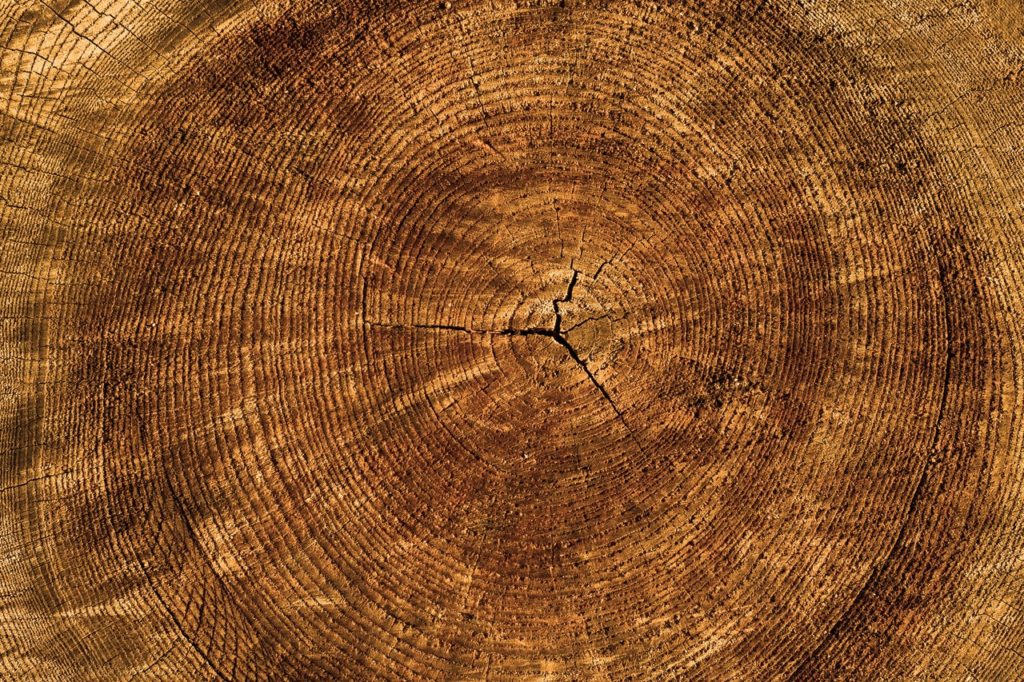
I learned this today. Trees have rings because they do not grow through the winter when it is too cold.
The study of tree rings is called dendrochronology. The word comes from ancient Greek: dendron means “tree”, khronos means “time”, and logia means “the study of”. So, it is the study of tree time. What a beautiful thought.
A tree trunk consists of five parts. On the very outside is the bark. The job of the bark is to protect the tree and keep things out. All of the insects that infect trees can generally burrow through the bark, but it keeps most things out. Then there is a layer called the phloem. This is the layer of the tree that transports nutrients from its roots to its leaves and sugars made from photosynthesis back down again. Then there is the vascular cambium. This is where the growing takes place. The next layer is the sapwood, which is responsible for drawing water up the tree and storing starch. The last layer is the heartwood, which is at the very center of the tree. This is made up of dead cells that have been filled with resin and minerals. It gives the tree support and stops things growing in the center of the tree.
Trees have rings because they grow from the outer edge of their trunks every year. As the winter approaches, trees lose their leaves and get ready for the winter. All of their energy is stored as sap in their trunk and roots. Trees use various different methods to survive the cold winter without freezing and when the temperature begins to rise again, they start to grow. The energy stored in the sap is brought up and used to produce new leaves and to grow the trunk.
The tree trunk growth starts very quickly. Once the temperature is warm enough, the vascular cambium starts to divide and produce new cells. These cells are large, less dense, and have thin cell walls. This gives them a much lighter color. They grow fast and produce the inner, lighter part of the tree ring. These cells are not as strong as the later ones, but they are large, which means that they can transport a lot of water.
As the year progresses, the growth rate of the tree begins to slow. The tree has more stored energy and access to water at the start of the growing season. In many climates, most of the rain is in the early part of the year. As the year progresses, the tree gets less water, and the growth rate naturally slows down. Cells produced in this period are smaller and have thicker cell walls. They appear much darker. These cells are much stronger than the earlier ones and they give trees their rigidity and strength. This layer of small cells also helps protect the inside of the tree from the extreme summer heat.
Then winter comes again, and the tree stops growing and shuts down for the cold season. This halt produces the dark line between one tree ring and the next. The smallest, darkest cells are produced just before the tree stops growing and the brighter, lighter cells are the first ones produced at the start of the following year.
Not all trees produce rings every year. Trees that grow in tropical environments or trees that have year-round access to water grow much faster and don’t stop growing. They have rings, but they are very thin, and they can make many of them in one year. Some trees that experience dry periods can stop growing and produce more than one ring a year as well.
Generally, trees in temperate climates produce one ring a year and these rings can be used to analyze weather patterns going back for as long as the tree has been alive. In droughts or seasons with bad conditions, the rings are narrow. In good growing seasons, the rings are wider. Studying the rings can also show forest fires, insect infestations, and many other things. However, it can be difficult to read the rings because some years can produce more than one ring. If there is a summer drought followed by heavy rainfall, the tree might have two rings for that year. Dendrochronologists try to get samples from several trees in the same area to try and find patterns.
So, tree rings are produced because the cambium part of the tree starts to grow quickly with the first warm weather of the spring. The growth rate slows down through the summer and stops just before the winter. The different densities of the cells that grow at different times of the year produce the ring. And this is what I learned today.
Photo by Pixabay: https://www.pexels.com/photo/brown-tree-log-355802/
Sources:
https://www.indefenseofplants.com/blog/2016/2/8/why-trees-have-rings-and-why-they-are-so-useful
https://scied.ucar.edu/learning-zone/how-climate-works/tree-rings-and-climate
https://www.theforestacademy.com/tree-knowledge/annual-growth-rings/#.YrRfM3bP3cs
https://en.wikipedia.org/wiki/Dendrochronology
https://en.wikipedia.org/wiki/Trunk_(botany)
https://northernwoodlands.org/outside_story/article/how-do-trees-know-when-to-wake-up
